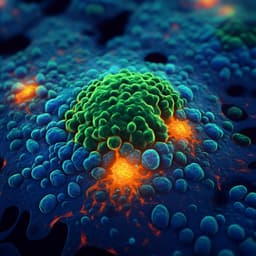
Medicine and Health
The RNA-binding protein HuR is a negative regulator in adipogenesis
D. T. C. Siang, Y. C. Lim, et al.
This groundbreaking study reveals the crucial role of Human antigen R (HuR) as a repressor during adipogenesis. By manipulating HuR levels in primary adipocyte cultures, researchers have uncovered significant implications for glucose intolerance and insulin resistance. The team from Duke-NUS Medical School provides vital insights into RNA processing and adipocyte development.
~3 min • Beginner • English
Introduction
Obesity involves excessive lipid accumulation in adipose tissue and is linked to metabolic diseases such as type 2 diabetes and cardiovascular disease. Adipose expansion occurs by hypertrophy and hyperplasia via adipogenesis. While many transcription factors governing adipogenesis are known, posttranscriptional regulation remains less understood. RNA-binding proteins (RBPs) control RNA fate from processing to decay and several RBPs affect adipocyte biology through splicing, miRNA regulation, translation, export, or stability. HuR (Elavl1) is a ubiquitous RBP that binds AU-rich elements in 3′UTRs to generally stabilize and enhance translation of target mRNAs. Although HuR is essential in development and various tissues (hematopoietic, immune, intestinal, neural), its physiological role in metabolic tissues is largely unknown. Prior cell-line work suggested HuR affects adipogenesis via C/EBPβ in 3T3-L1 cells. The present study tests the hypothesis that HuR negatively regulates adipogenesis in vivo and in vitro, defining its role across adipose depots and elucidating underlying posttranscriptional mechanisms.
Literature Review
Earlier studies identified transcriptional regulators of adipogenesis and multiple RBPs influencing adipocyte biology: SFRS10 and Sam68 regulate alternative splicing impacting adipocyte development and lipid metabolism; KSRP ablation promotes WAT browning by reducing miR-150; IMP2 (IGF2BP2) represses translation of UCP1 and mitochondrial mRNAs, affecting energy metabolism; PSPC1 facilitates nuclear export of adipocyte RNAs (e.g., EBF1), promoting adipogenesis; Ybx2 regulates mRNA stability in cold-induced BAT activation. HuR broadly stabilizes ARE-containing mRNAs and is critical in diverse cell types (hematopoietic survival, T/B cell function, myeloid inflammation control, neuroprotection, intestinal epithelium). In 3T3-L1, HuR depletion attenuated differentiation via effects on C/EBPβ protein. However, depot-specific and in vivo adipose roles of HuR were unknown.
Methodology
- In vitro adipocyte differentiation: Primary mouse brown and white preadipocytes isolated from 3–4-week-old C57BL/6 mice (SVF from BAT, iWAT, eWAT). Differentiation induced with standard cocktail (insulin, dexamethasone, IBMX, rosiglitazone). Human primary brown and subcutaneous white preadipocytes (Zen-Bio) were cultured and differentiated per established protocols.
- Genetic manipulation in vitro: Retroviral shRNAs (pSUPER) to knock down HuR; retroviral overexpression (XZ201 vector) of mouse or human HuR in mouse and human preadipocytes. Lipid accumulation assessed by Oil Red O staining; marker expression by qRT-PCR.
- In vivo models: Adipose-specific HuR knockout (HuR-FKO) generated by crossing Hur flox/flox with Adipoq-Cre; BAT-specific knockout (HuR-BATKO) with Ucp1-Cre. Confirmation of HuR deletion by qRT-PCR and western blot in BAT, iWAT, eWAT.
- Physiological phenotyping: Body weight, length, food intake, energy expenditure; body composition by EchoMRI; adipose depot weights; histology (H&E) and macrophage immunostaining (F4/80); in vivo insulin signaling (insulin IP, p-AKT in eWAT by western blot); glucose tolerance test (GTT) and insulin tolerance test (ITT).
- Transcriptomics: RNA-seq on pooled samples (eWAT and iWAT: n=3/group; BAT: n=2/group), alignment to mm10 (Tophat), quantification (Cufflinks FPKM), low-expression filtering; Gene Set Enrichment Analysis (MSigDB Hallmarks) on pre-ranked log2 fold changes.
- HuR targets: RNA immunoprecipitation followed by RNA-seq (RIP-seq) from eWAT using anti-HuR vs IgG; ARE motif prediction (AREsite2). Validation via RIP-qPCR.
- RNA–protein interaction mapping: In vitro RNA pull-down with biotinylated Insig1 3′UTR uridine-rich fragments; western blot for HuR.
- Translational profiling: Ribosome profiling (RPF) in control vs HuR-FKO eWAT; QC for start codon accumulation; calculation of translational efficiency (RPF/mRNA).
- mRNA stability assays: psiCHECK2 reporter bearing full-length or mutant Insig1 3′UTR co-transfected with HuR or control in 293T cells; transcriptional shutoff with actinomycin D; decay measured by qRT-PCR for hRluc (reporter), hLuc (control), and 18S. In primary white adipocytes from control vs HuR-FKO mice, endogenous Insig1 and 18S decay measured after actinomycin D.
- Additional assays: Overexpression of Insig1 in primary adipocytes to assess effects on differentiation; combined HuR overexpression with Insig1 knockdown to test epistasis.
- Statistics: Mean ± SEM; Student’s t-test, one-way ANOVA, Kolmogorov–Smirnov for cumulative distributions; significance at p<0.05. Ethics approvals for animal and human tissue work stated.
Key Findings
- HuR expression decreases during adipocyte maturation in BAT, iWAT, and eWAT; lower in mature adipocytes vs SVF.
- In vitro differentiation: HuR knockdown in primary mouse brown and white preadipocytes increased adipocyte markers and lipid accumulation; HuR overexpression reduced lipid accumulation and decreased BAT-selective and pan-adipocyte markers. Human preadipocytes showed similar repression by HuR overexpression. Human HuR also inhibited mouse adipocyte differentiation.
- In vivo HuR-FKO (Adipoq-Cre) mice: No change in body weight, length, food intake, or energy expenditure, but increased total fat mass by EchoMRI, driven mainly by enlarged eWAT; eWAT adipocytes hypertrophic; reduced insulin-stimulated AKT phosphorylation in eWAT; whole-body glucose intolerance and insulin resistance on GTT and ITT.
- eWAT transcriptomics: GSEA showed adipogenesis pathway upregulated (NES ~1.35, p=0.038); increased expression of adipogenic/lipogenic genes (e.g., Pparγ, Fabp4, Adipoq, Lpl, Dgat1/2, Glut4); inflammatory and interferon-γ response pathways upregulated; elevated inflammatory markers (Il6, Tnfα, F4/80, Cd68, etc.) and increased macrophage staining.
- iWAT transcriptomics: Strong upregulation of adipogenesis (NES=2.24, p<0.001) and fatty acid metabolism (NES=2.31, p<0.001); oxidative phosphorylation markedly up (NES=3.01, p<0.001). Browning markers (Ucp1, Dio2, Fabp3, Elovl3, beige markers Cd137, Tmem26) increased at mRNA; UCP1 and CIDEA up at protein level. Indicates enhanced adipogenesis and browning.
- Depot specificity: Oxidative phosphorylation increased in iWAT but not eWAT; interferon/TNFA signaling elevated in eWAT but not iWAT; IL6/JAK/STAT3, angiogenesis, hypoxia repressed in iWAT; adipogenesis and fatty acid metabolism up in both depots.
- BAT transcriptomics: Myogenesis pathway significantly downregulated (NES = -2.61, p<0.001), consistent with enhanced commitment to brown fat lineage. Increased BAT markers (Ucp1, Pgc1a, Fabp3) and pan-adipogenic markers; decreased muscle markers; protein validation: UCP1 and PGC1α increased, DESMIN decreased.
- BAT-specific knockout (HuR-BATKO): Confirmed HuR loss in BAT; smaller brown adipocytes; increased brown fat marker expression; no significant systemic metabolic changes or effects on eWAT.
- HuR target identification: RIP-seq from eWAT identified 200 top HuR-bound transcripts enriched for RNA metabolism processes; most targets contained ARE motifs. HuR-targeted mRNAs were more downregulated in HuR-FKO tissue, consistent with a stabilizing role.
- Translation: Ribosome profiling showed no significant change in translational efficiency globally upon HuR knockout.
- Insig1 as a key target: Insig1 mRNA and protein reduced across adipose depots in HuR-FKO; HuR binds Insig1 mRNA (RIP-qPCR) and Insig1 3′UTR uridine-rich fragments (RNA pull-down). Reporter assays: HuR increased hRluc-Insig1 3′UTR half-life from 2.4 h to 6.7 h; effect lost when HuR binding sites were mutated. In primary adipocytes, endogenous Insig1 half-life decreased from 4.3 h (control) to 1.2 h (HuR-deficient), with 18S unchanged. Insig1 overexpression repressed adipocyte differentiation; Insig1 knockdown attenuated HuR overexpression’s anti-adipogenic effect.
- Previously proposed targets HMGB1 and C/EBPβ did not change in adipose tissues and were not identified by RIP-seq, suggesting cell-type/context specificity.
Discussion
The data demonstrate that HuR functions as a negative regulator of adipogenesis, acting predominantly during terminal differentiation (consistent with Adipoq-Cre expression timing and HuR dynamics during differentiation). Loss of HuR in adipose tissue increases fat mass and impairs systemic glucose homeostasis, while exerting depot-specific effects: promoting browning in iWAT, enhancing inflammation in eWAT, and suppressing myogenesis signatures in BAT. Mechanistically, HuR stabilizes a broad set of ARE-containing transcripts; among them, Insig1—an established inhibitor of adipogenesis—emerges as a functionally important mediator, with direct HuR binding to Insig1 3′UTR increasing its mRNA stability and with genetic interaction tests supporting its role downstream of HuR. Ribosome profiling suggests HuR’s major impact in adipose tissue is on mRNA abundance/stability rather than translation. The divergence from prior 3T3-L1 findings (e.g., C/EBPβ, HMGB1) underscores cell-type and context dependence. Collectively, the findings clarify a posttranscriptional layer of adipogenic control by HuR and highlight depot-specific adipose responses to loss of this RBP.
Conclusion
This study establishes HuR (Elavl1) as an important posttranscriptional brake on adipogenesis across adipose depots. In vitro, HuR suppresses adipocyte differentiation; in vivo, adipose-specific HuR loss increases fat mass and leads to glucose intolerance and insulin resistance, with depot-specific programs (iWAT browning, eWAT inflammation, BAT anti-myogenic shift). Mechanistically, HuR binds and stabilizes Insig1 mRNA via 3′UTR interactions, contributing to its anti-adipogenic action, while broadly stabilizing many ARE-containing transcripts. Future work should define the full repertoire of HuR targets in each depot, delineate additional RNA processing steps (e.g., splicing) influenced by HuR, resolve depot-specific targeting and response mechanisms, and assess potential roles of HuR in earlier commitment stages of adipogenesis and in human adipose physiology in vivo.
Limitations
- Adipoq-Cre–mediated deletion targets terminal differentiation stages; potential roles of HuR in precursor commitment were not addressed.
- Although Insig1 was validated as an important target, the phenotypes likely reflect combined effects on multiple transcripts; additional direct targets mediating depot-specific outcomes remain to be identified.
- BAT-specific deletion altered BAT gene programs and morphology but did not impact systemic metabolism, indicating limited systemic sensitivity to BAT HuR status under baseline conditions.
- Translational regulation by HuR appeared minimal in adipose tissue based on ribosome profiling, but subtle or stimulus-dependent effects cannot be excluded.
- RIP-seq and RNA-seq were performed on pooled tissue samples with modest replicate numbers, which may limit detection of some targets or pathways.
Related Publications
Explore these studies to deepen your understanding of the subject.







